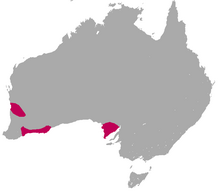Broad-faced potoroo
| Broad-faced potoroo[1] Temporal range:
| |
|---|---|

| |
| Stuffed specimen at the Natural History Museum Pisa | |
| Scientific classification | |
| Domain: | Eukaryota |
| Kingdom: | Animalia |
| Phylum: | Chordata |
| Class: | Mammalia |
| Infraclass: | Marsupialia |
| Order: | Diprotodontia |
| Family: | Potoroidae |
| Genus: | Potorous |
| Species: | †P. platyops
|
| Binomial name | |
| †Potorous platyops | |

| |
The broad-faced potoroo (Potorous platyops) is an extinct
The habitat of the broad-faced potoroo is almost entirely unknown, but unlike its relatives, such as the long-nosed potoroo
Taxonomy
The first description was published by John Gould,[3] using a specimen obtained by his collector John Gilbert at "Walyema Swamps near Northam, Western Australia".[4] Gilbert visited this inland region while collecting around the recently established Swan River Colony. The site he referred to was determined to be Lake Walyormouring.[5]
The single specimen forwarded to Gould was presented to the
There were few collected after Gould's initial description. There was one animal collected by James Drummond and recorded in a letter in the 1840s, the collector George Masters prepared four specimens in the 1860s, presumably when he made a large collection of taxa at Mordup. The last collection of living Potorous platyops was in 1874, collected by William Webb and are now held at the Macleay Museum in Sydney.[6]Curator and collector
Common names include broad-faced potoroo and a name from the
Description
The broad-faced potoroo is a member of the genus The species is presumed to have become extinct sometime after the last recorded capture of the animal in 1875, and sometime before 1905.
The colour of the
Ecology
The behaviour of the species has not been recorded,[14] and nothing is known of its diet. The scant record of its habitat includes those provided by John Gilbert's informants, one of whom said, "All I could glean of its habits was that it was killed in a thicket surrounding one of the salt lagoons in the interior".[16]
An assessment of documents prior to the 20th century concluded the only ecological change to affect the population were anecdotal reports of a "disease", similar to one that had resulted in the sudden absence of similar species. A synthesis combining other historical evidence proposes what may have been an epizootic during the 1890s that precipitated their extinction. No historical evidence could be found to link the conclusion of South African collector Guy C. Shortridge, writing in 1910, that ecological changes such as bushfire and the introduction of cats were directly linked to the species' decline.[6][17]
Guy Shortridge searched extensively for this species on his collecting expedition near
Distribution
The few records of live specimens are restricted to Southwest Australia. The species could have already been near-extinct when Gilbert obtained his specimen, and no specific localities are known with any certainty.[14][16]
Some evidence indicates that P. platyops, like the desert-dwelling rat-kangaroo (
References
- OCLC 62265494.
- . Retrieved 13 November 2021.
- ^ a b c d Gould, J. (1844). "Exhibition and character of a number of animals, &c. transmitted from Australia by Mr. Gilbert". Proceedings of the Zoological Society of London. 1844: 103–104. Retrieved 27 March 2019.
- ^ Claridge 2007, p. 5.
- ^ a b c "Species Potorous platyops (Gould, 1844)". Australian Faunal Directory. Australian Government. Retrieved 27 March 2019.
- ^ a b c d e f Abbott, I. (2008). "Historical perspectives of the ecology of some conspicuous vertebrate species in south-west Western Australia" (PDF). Conservation Science W. Aust. 6 (3): 42–48.
- Finlayson, H. H. (1938). "On a new species of Potorous (Marsupialia) from a cave deposit on Kangaroo Island, South Australia". Transactions of the Royal Society of South Australia. 62: 132–140.
- ^ Thomas, O. (1888). Catalogue of the Marsupialia and Monotremata in the collection of the British Museum (Natural History). London: Printed by order of the Trustees. p. 116.
- . Transactions of the Linnean Society of London. 2. 9: 147–150.
- Waterhouse, G. R. (1846). A Natural History of the Mammalia. London: H. Baillière. pp. 231–232.
- Species Profile and Threats Database.
- ^ a b Abbott, Ian (2001). "Aboriginal names of mammal species in south-west Western Australia". CALMScience. 3 (4): 451.
- .
- ^ ISBN 9780195573954.
- ^ Claridge 2007, p. 28.
- ^ a b c d Claridge 2007, pp. 17, 19, 84.
- ^ . Proceedings of the Zoological Society of London. 1909. Academic Press, [etc.]: 803–848.
- ^ Butler, W. H.; Merrilees, D. (1971). "Remains of Potorous platyopus (Marsupialia, Macropodidae) and other mammals from Bremer Bay, Western Australia". Journal of the Royal Society of Western Australia. 54: 53–58.
- doi:10.1071/AM09020.
Sources
- Claridge, A. W.; Seebeck, J. H.; Rose, R. (2007). Bettongs, potoroos, and the musky rat-kangaroo. Collingwood, Victoria: CSIRO Pub. ISBN 9780643093416.
External links
- biodiversitylibrary.org photographic series of sub-fossil remains by H. H. Finlayson, 1938.

